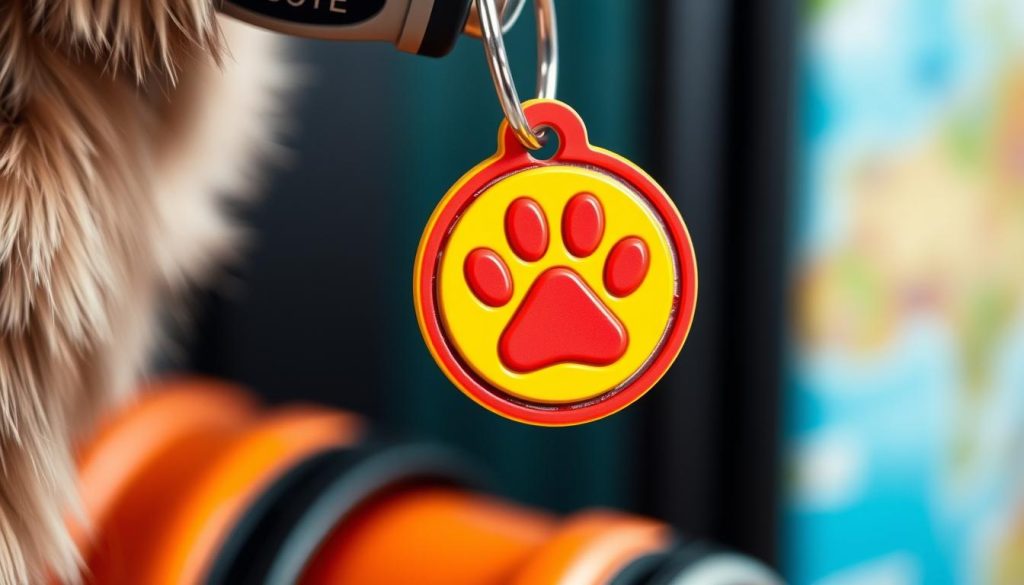As a devoted pet owner, the thought of my beloved dog or cat going missing while on vacation sends shivers down my spine. Sadly, millions of pets disappear every year in the United States. This leaves their worried owners heartbroken and desperately searching for their furry friends. But fear not! This guide will give you the knowledge and tools to keep your pet safe and sound, even when traveling.
From the importance of microchipping and identification tags to escape-proofing your home and proper training, I’ll share essential lost pet travel tips. These tips can increase your chances of a joyful reunion if your four-legged companion ever goes missing on vacation. By following these practical steps, you can rest assured that your pet’s safety is a top priority, no matter where your adventures take you.
The Importance of Microchipping
Keeping your pet safe is very important. Microchipping is a great way to make sure they are well. This tiny device has a unique number that helps find lost pets quickly.
A Crucial Lifeline for Lost Pets
When your pet goes missing, time is critical. A microchip is like a lifeline. It lets vets and shelters call you right away. It’s a permanent way to identify your pet, so they can always find their way home.
Keeping Your Contact Information Up-to-Date
Microchipping works best with up-to-date contact info. Make sure to update your pet’s microchip with your new phone number, address, and email. This way, if your pet gets lost, you can be found quickly.
Getting pet microchips is a smart move. It helps reunite lost pets with their families. Keeping your pet identification current is a key step in protecting your pet and bringing them back home.
Identification Tags: A Secondary Layer of Protection

Microchipping is the best way to identify pets, but ID tags on collars add an extra layer of safety. These tags help you find your pet if they get lost. They are key in getting your furry friend back to you.
Make sure your pet’s tags have their name, your name, and your phone number. This info helps someone who finds your pet get in touch with you. Bright collars make your pet stand out at night. This increases their chances of being seen.
- Invest in high-quality, durable pet ID tags that won’t fade or fall off easily.
- Choose a collar that fits your pet comfortably and securely, without being too tight or too loose.
- Consider a collar with reflective strips or patterns to enhance your pet’s visibility, especially during low-light conditions.
- Regularly check your pet’s tags and collar to ensure the information is up-to-date and the collar is in good condition.
Using microchipping and ID tags together creates a strong safety system for your pet. This mix increases the chances of finding your pet if they get lost.
Escape-Proofing Your Home

As pet owners, we want to keep our furry friends safe and sound. Microchips and ID tags help, but securing your home and yard is key. With a few easy steps, you can make a safe place for your pets.
Securing Your Yard for Dogs
For dog owners, checking your fence and gates is a must. Look for gaps or weak spots your dog could get through. Make sure gates close well and think about extra locks to stop them from opening by accident. Always keep your dog on a leash outside, especially near exits or places they don’t know.
Keeping Cats Safely Indoors
Cats love to explore, so we need to keep them in. Make sure windows and balconies are secure. Use cat-proof screens or fencing to keep them safe outside. Think about cat fencing or enclosures for fresh air without the risk of getting out.
Putting pet safety at home first can cut down on pet escapes. This way, your pets stay safe and sound, whether they walk on four legs or two. A bit of effort keeps your pets happy and protected.
Lost Pet Travel Tips

Traveling with your pet can be fun but needs extra care for their safety. Before you go, get a secure pet carrier that follows airline rules. This keeps your pet safe and stops them from escaping at stops or new places.
Make sure your pet has a microchip and up-to-date ID tags. This helps if they get lost on vacation. Always keep your pet on a leash during breaks to stop them from getting lost in new places.
What to Do If Your Pet Goes Missing on Vacation
If your pet gets lost while on vacation, act fast. Look around where you last saw them, calling their name and using treats. Make “Lost Pet” flyers with a photo and your contact info, and post them around.
Talk to local animal shelters, vets, and police to help find your pet. Use social media to tell more people about your lost pet. The more people who know, the better your chances of finding them.
Being prepared and acting fast can help you find your pet if they get lost. Always put your pet’s safety first and be ready for anything unexpected.
Training and Behavior Management
As a pet owner, keeping your furry friend safe is key. One important way to do this is by preventing them from escaping. This can be done with good training and managing their behavior. By fixing the reasons for their anxiety and setting strong habits, we can lower the chance of them running away.
First, make sure your pet knows the recall command. This means they’ll come to you even when there are distractions. Use consistent training and positive rewards to teach this important skill. Also, help your pet overcome separation anxiety or fears of loud noises, like during thunderstorms, to stop them from escaping in panic.
- Invest time in training your pet to have a strong recall command.
- Desensitize your pet to sources of anxiety, like loud noises, to reduce the risk of escape attempts.
- Ensure your pet’s environment is secure and escape-proof, with proper fencing and secure windows and doors.
With good pet training, behavior management, and a safe living space, you can lower the risk of your pet running off. A well-trained and happy pet is less likely to escape, keeping them safe with you.
Enlisting Local Help When Traveling
If your pet goes missing while you’re away, act fast. Time is key. Search the area well and visit local animal shelters and vet clinics to file a Lost Pet Report. This step can boost your pet’s chances of coming home.
Contacting Animal Shelters and Businesses
Talk to local animal shelters, vet clinics, and pet-friendly businesses. Give them details about your lost pet, like its looks and how to reach you. These places might help find your pet or watch for it.
Utilizing Social Media
- Post your pet’s info on social media.
- Use online lost pet boards in your area for community help.
- Ask local volunteer groups or animal welfare groups for help in finding your pet.
Using your local community and social media can really help find your pet. A fast and thorough approach can connect you with important resources and people. This way, you can bring your pet back home safely.
Reuniting with Your Lost Pet
Losing a pet is very sad, but don’t give up hope. Many pets find their way back home, even after a long time. If you find a lost pet, be careful, offer food and water, and keep them safe.
Then, use any tags or microchips to contact the owner or call the local animal shelter. Animal shelters have ways to find pets and connect them with their families. They use microchip registries and lost pet reports to help.
By reaching out to shelters and using social media, you can help find your pet. Persistence is important. Pets can turn up days, weeks, or even months later. With the right steps and support, you might get your pet back.
Stay hopeful and keep looking. With patience and hard work, you can bring your pet home. This will make both you and your pet very happy.

